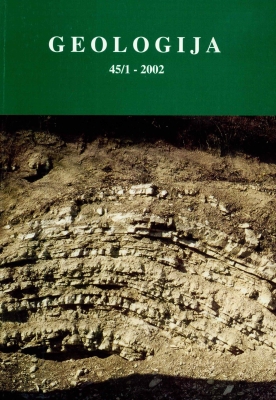Development of a Lithocodium (syn. Bacinella irregularis)-reef-mound- A patch reef within Middle Aptian lagoonal limestone sequence near Nova Gorica (Sabotin Mountain, W-SIovenia)
DOI:
https://doi.org/10.5474/geologija.2002.006Abstract
A Middle-Aptian (zone of Palorbitolina lenticularis) „patch reef“ of about 40 m maximum thickness with marked morphology was analyzed at the Sabotin Mountain near Nova Gorica. It is developed above an basal unit of superficial oolites within lagoonal sediments and is overlain by shallow subtidal to intertidal sediments which reveal short time periodically subaerial exposure and early diagenetic freshwater influxes (birds eyes, vadose silt, characeans). Above these sediments within the zone of Salpingoporella dinarica finebedded to platy, laminated bituminous limestones occur. The central part of the reef structure reveals an alternation of individual lenses of Lithocodium-boundstones and of rudist-beds (up to 4 m thickness) which are separated by coarse- to medium-grained, moderately to poorly sorted bioclastic sands. These facies types show also lateral interfingering and are concentrated in the central part of the buildup where the greatest thickness can be observed and where packstones, grainstones and boundstones prevail. The neighbouring lagoonal sediments which consist of mudstones and wackestones predominantly were analyzed in the so-called Sabotin-standardprofile which is located north of the patch reef at a lateral distance of about 300 m. Three vertical profiles (A = 90 m, B = 100 m, C = 64 m thickness) were analyzed. The middle profile B of greatest thickness is taken as reference profile and documents best the vertical facies development within the patch reef directly overlying a basal unit of peloidal packstones with superficial ooids. The patch reef itself is characterized by the faunal associations within the unit rich in Lithocodium and rudists. It is overlain by a subtidal unit of peloidal mudstones with very minor biogenic allochems. An intertidal unit above rich in birds-eyes and vadose silt is followed by fine-laminated black shales which are covering the general seqeunce of interfingering patch-reef - lagoonal sediments. Using different time lines (marker horizons) for correlation it can be shown that already very early differential compaction of fine-grained uncemented sediments in comparison to the core area of the patch reef is of great importance. The greater thickness of the patch reef itself is caused by an intensive early diagenetic marine phreatic cementation within the core zone and by the early fixing of sediment by Lithocodium aggregatum (syn. Bacinella irregularis) resulting in a greater resistivity against compaction. Furthermore a lagoonal side and an more open marine side of the patch reef can be determined. Lithocodium aggregatum is the main constructing organism within the buildup investigated, beginning with the incrustation of varying substrates and biogenic particles. Finally, a dense network of encrustation-sequences is formed interfingering with the general sedimentary textures intensively and resulting in larger „biogenic-cemented“ patches within the sediment. The correlation of the three profiles A, B, and C allows to reveal the history of differential compaction of the associated lagoonal sediments in comparison to the more massive patch reef limestones. It becomes obvious that the main compaction must have occurred within the time span of about 50 m sediment-deposition overlying the patch reef. Differential compaction resulted in differences in thickness of about 10 m from the patch reef (profile B) to the more lagoonal influenced sediments (profile A) within a lateral distance of about 50 m.Downloads
How to Cite
Koch, R., Moussavian, E., Ogorelec, B., Skaberne, D., & Bucur, I. I. (2002). Development of a Lithocodium (syn. Bacinella irregularis)-reef-mound- A patch reef within Middle Aptian lagoonal limestone sequence near Nova Gorica (Sabotin Mountain, W-SIovenia) . Geologija, 45(1), 71–90. https://doi.org/10.5474/geologija.2002.006
Issue
Section
Articles

